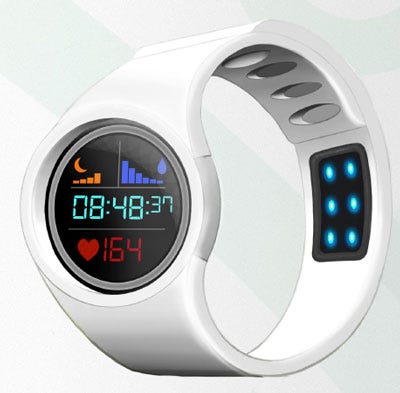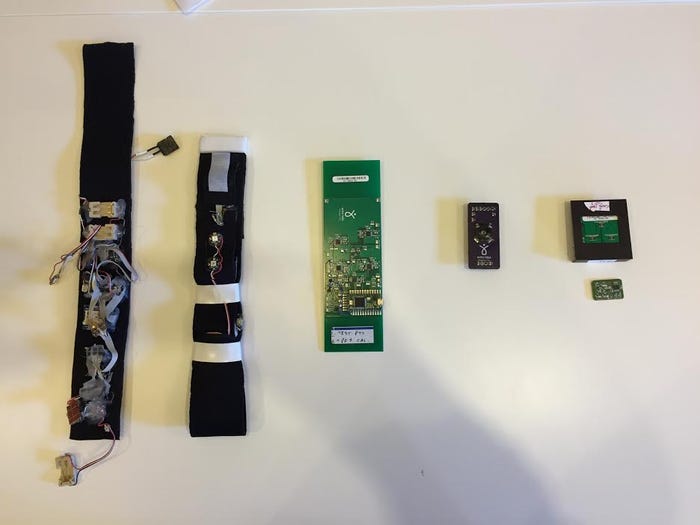A Wearable That Monitors Your Blood Noninvasively
April 16, 2015
A startup has invented a wrist-worn technology that uses light to analyze everything from hydration levels to blood pressure.
Brian Buntz
|
EchoLabs technology uses spectroscopy to measure health metrics. Shown here is a rendering of its future technology. |
The startup EchoLabs hopes to pioneer what it terms third-generation wearable technology, providing more meaningful data than step counters (representing the first wave of wearables) or activity monitors like the Basis Watch and the Amiigo wristband (representing the second wave). More promising, however, is that the company's technology would provide robust actionable recommendations to users, and would track a greater variety of physiological data, including blood pressure, pulse, hydration, and blood gas levels.
"We've invented a technology that pulses light through the tissue to the bloodstream and analyzes the reflection. That enables us to measure--completely noninvasively--a few different molecules of the blood and track them over time. That unlocks a completely new aspect of healthcare related to monitoring vitals continuously," says Pierre-Jean Cobut, the company's cofounder. (Incidentally, Cobut along with cofounder Elad Ferber were listed in Business Insider's Stanford Business Students Who Are Going To Change The World.)
Monitoring Health Continuously
The ability to monitor medically relevant metrics such as blood pressure continuously and provide actionable recommendations has attracted the attention of insurance companies as well as seed funding from investors.
It could also provide an answer to problems such as white coat hypertension, where a patient who gets anxious during office checkups demonstrates high blood pressure while in the doctor's office but not at home.
"We can actually measure blood pressure continuously in your normal life and keep better track of how you are doing," Cobut says.
The technology leverages spectroscopy to analyze blood, using transmitters to send light and other electromagnetic frequencies to the skin and measuring the light that reflects back. "The reflectance is not only from skin. When you beam electromagnetic waves into the tissue, the light is being reflected from every element it hits--the arteries, skin, bone, and muscle. We read the reflectance with a receiver and can analyze how exactly the blood flow is functioning. In addition to heart rate, we can measure things like blood gas concentrations and other metrics" says Elad Ferber, the company's CTO and cofounder.
It is already possible to measure metrics like blood pressure and heart rate in a doctor's office or hospital bed. "But we've made a truly wearable device that can measure these things. Regardless of what the user is doing--whether the user is engaged in vigorous physical activity or if you are driving, it always works. And that is not something that has ever been done before," says Cobut.
The Importance of Accuracy
The raw signal we get from the optical sensor is very noisy -- the signal to noise ratio is 1 to 100, which means 99% is noise. We are able to capture the 1% that is relevant to keep the measurements accurate.The raw signal we get from the optical sensor -- what you call the signal to noise ratio is 1 to 100, which means in the signal, 99% is noise. We are able to capture the 1% that is relevant to keep the measurements accurate.
It has been difficult for many firms to offer accurate cuffless blood pressure. Ferber, the company's CTO, says that, while he can't get into the details of how the algorithm works, he explains that the company's technology is accurate and that it makes based on the analysis of well-known metrics like pulse transit time. "We have our own take on that so we can achieve very accurate results," he says.
Accuracy is high on the company's priority list. While many firms have developed wearable products that measure heart rate, few do so accurately. "The problem with many of these devices is that the hardware is well done but the algorithm less so," Cobut explains. "We won't need to have a person hold still and hold their breath to avoid interfering with the signal. We spent a lot of time on the first layer of the technology making it robust in any circumstance."
The company is now in a testing phase and will likely launch a consumer-facing application before it readies a medical technology that would require FDA clearance. "We are very much a health company so going after FDA approval down the road makes sense for us."
In terms of testing, the company is now working with prominent athletes that include Olympic athletes, a major league soccer franchise, and triathletes.
|
A look at the prototype-stage EchoLabs technology. |
Probing the Body for Actionable Insights
The observation the company has had from the beginning is that wearable technology is interesting conceptually but the technology currently on the market is still somewhat rudimentary.
"Our analysis was that many people stop using fitness trackers because the base data that they measure is so basic that nothing that interesting can come out of it," Cobut says.
The company decided to take a different approach. "Instead of looking at an external metric like step counts, we like inside of the body and look at the impact of basically everything you do. We could look at physical activity, hydration, quality of your sleep, or even certain diseases," Cobut explains. "We could look at these different metrics and do trend analysis." A person running a marathon could use the technology to measure hydration levels.
"We could also do a projection of what your body might look like in an hour," Cobut says. "We could tell an athlete: 'if you keep up your current activity level, within an hour, you could be completely dehydrated and on the side of the road. So now is a good time to drink some water.'"
The company plans on using information like this to create feedback loops that can help drive changes in behavior or fine tune an athlete's training regimen. "You measure, analyze, and then the user acts on the information from that and feels the results," Cobut concludes.
Refresh your medical device industry knowledge at BIOMEDevice Boston, May 6-7, 2015. |
Brian Buntz is the editor-in-chief of MPMN and Qmed. Follow him on Twitter at @brian_buntz.
Like what you're reading? Subscribe to our daily e-newsletter.
About the Author(s)
You May Also Like




